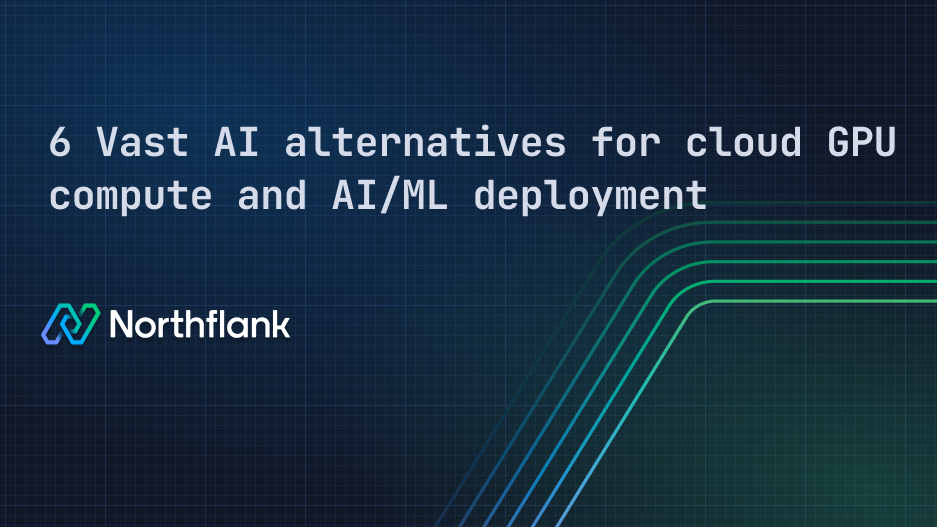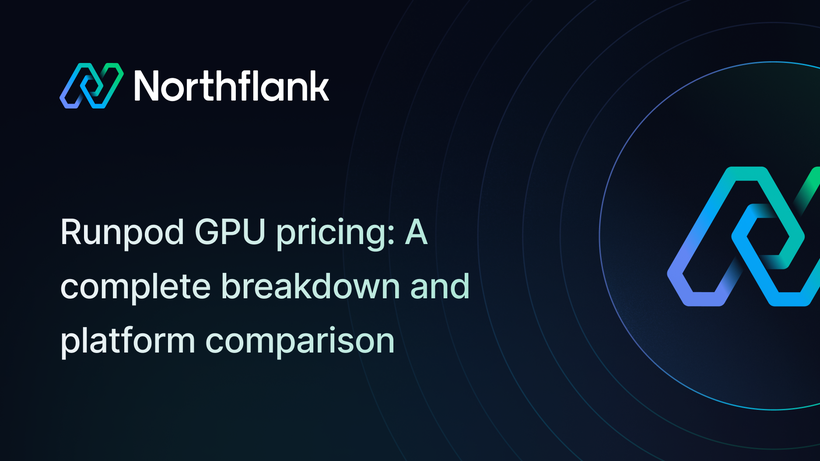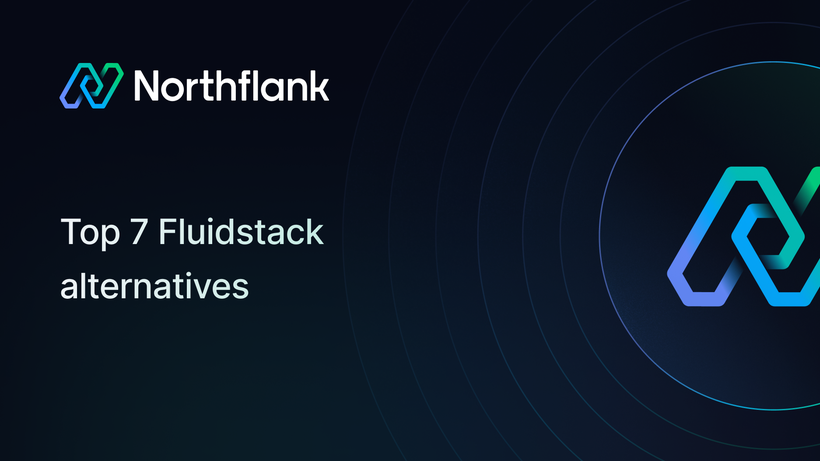

6 best Vast AI alternatives for cloud GPU compute and AI/ML deployment
Vast AI is one of the most affordable and flexible ways to access GPU compute. With a global marketplace of providers, container-based deployments, and granular filtering for hardware specs, it’s a strong option for cost-conscious teams running training jobs, experiments, or batch workloads.
But as projects grow, so do the infrastructure demands. You might need better uptime, more consistent performance, or deployment workflows that integrate with your CI/CD stack. At that point, managing raw containers across community hosts can slow you down.
That’s where alternatives like Nortflank come in. If you need production-grade deployment, built-in orchestration, or persistent services running alongside GPU jobs, there are platforms that offer more control without adding complexity. In this guide, we’ll compare the top Vast AI alternatives and help you choose the right tool for your workload.
If you're short on time, here’s a snapshot of the top Vast AI alternatives. Each tool has its strengths, but they solve different problems, and some are better suited for real-world production than others.
| Platform | Best For | Why It Stands Out |
|---|---|---|
| Northflank | Full-stack AI products: APIs, LLMs, GPUs, frontends, backends, databases, and secure infra | Production-grade platform for deploying AI apps — GPU orchestration, Git-based CI/CD, Bring your own cloud, secure runtime, multi-service support, preview environments, secret management, and enterprise-ready features. Great for teams with complex infrastructure needs. |
| RunPod | Budget-friendly, flexible GPU compute | Fast setup, competitive pricing, and support for both interactive dev and production inference |
| Baseten | ML APIs and demo frontends | Smooth model deployment with built-in UI tools and public endpoints, no DevOps required |
| Modal | Async Python jobs and batch workflows | Code-first, serverless approach that works well for background processing and lightweight inference |
| Vertex AI | GCP-native ML workloads | Good for teams already on GCP, with access to AutoML and integrated pipelines |
| SageMaker | Enterprise-scale ML systems | Full-featured but heavyweight, better suited for teams deep in the AWS ecosystem |
If you've used Vast AI before, you know it appeals to teams who want to access cheap cloud GPUs. Here's why many start with it:
- Price efficiency: Vast’s decentralized GPU marketplace allows users to find some of the lowest prices in the market. Bidding on interruptible instances can yield even cheaper rates for non-critical tasks like model training or data preprocessing.
- Custom container deployments: You can launch your own containerized workloads without conforming to vendor-specific formats. This flexibility makes Vast especially appealing for ML engineers who need full control over their environment.
- Granular hardware filtering: The search interface lets you filter offers based on GPU model, VRAM, system memory, bandwidth, disk size, and trust level. That level of hardware specificity is hard to find elsewhere.
- Horizontal scaling through liquidity: With access to thousands of distributed GPUs, Vast can support horizontally scaled training jobs — ideal for deep learning practitioners working on large-scale experiments.
- Zero commitment and pay-as-you-go: There’s no account lock-in, credit requirement, or platform-specific configuration overhead. You only pay for the compute you use, with the freedom to spin up and tear down workloads at will.
We have just covered what makes Vast AI a good choice for many teams. But like most tools, it is not perfect, especially for teams looking to deploy full-stack workloads or those seeking a platform with built-in Git and CI/CD integrations.
Vast AI doesn’t connect to GitHub, GitLab, or any CI/CD provider. There’s no native pipeline, rollback, or tagging. You’re managing builds manually, pushing containers by hand, restarting pods, and hoping nothing breaks.
Platforms like Northflank connect directly to your Git repos and CI pipelines. Every commit can trigger a build, preview, or deploy automatically. No custom scripts required.
Everything you launch goes straight to production. There’s no staging, preview branches, or room for safe iteration.
This kills experimentation. There’s nowhere to test model variations or feature branches without risking live traffic.
Platforms like Northflank provide full environment separation by default, with staging, previews, and production all isolated and reproducible.
If your model gets slow or crashes, you’re flying blind. No Prometheus, request tracing, or logs unless you manually SSH and tail them.
There’s no monitoring stack. You can't answer basic questions like: How many requests are failing? How many tokens per second? GPU utilization?
With platforms like Northflank, observability is built in. Logs, metrics, traces, everything is streamed, queryable, and tied to the service lifecycle.
You can’t scale pods based on demand. There’s no job queue. No scheduled retries. Every container is static. That means overprovisioning and paying for idle GPU time, or building your own orchestration logic.
By default, Northflank supports autoscaling, scheduled jobs, and queue-backed workers, making elastic GPU usage feel native.
Vast AI can run one thing: a container. If you need a frontend, a backend API, a queue, a DB, a cache? You’re cobbling together services across platforms. That fragmentation adds latency, complexity, and risk.
Northflank treats multi-service apps as first-class citizens. You can deploy backends, frontends, databases, and cron jobs—fully integrated, securely networked, and observable in one place.
Vast AI is built for trusted team environments, but it doesn’t offer secure runtime isolation for executing untrusted or third-party code. There’s no built-in sandboxing, syscall filtering, or container-level hardening. If you're running workloads from different tenants or just want extra guarantees around runtime isolation, you’ll need to engineer those protections yourself.
By contrast, Northflank containers run in secure, hardened sandboxes with configurable network and resource isolation, making it easier to host untrusted or multitenant workloads out of the box safely.
Vast AI runs on its own infrastructure. There’s no option to deploy into your own AWS, GCP, or Azure account. That means: no VPC peering, private networking, or compliance guarantees tied to your organization's cloud, and no control over regions, availability zones, or IAM policies. If your organization needs to keep workloads within a specific cloud boundary for compliance, cost optimization, or integration reasons, Vast AI becomes a non-starter.
By contrast, platforms like Northflank support BYOC, letting you deploy services into your own cloud infrastructure while still using their managed control plane.
Vast AI works if all you need is a GPU and a container.
But production-ready AI products aren’t just containers. They’re distributed systems. They span APIs, workers, queues, databases, model versions, staging environments, and more. That’s where Vast AI starts to fall short.
As soon as you outgrow the demo phase, you’ll need infrastructure that supports:
- CI/CD with Git integration – Ship changes confidently, not by SSH.
- Rollbacks and blue-green deploys – Avoid downtime, roll back instantly.
- Health checks and probes – Know when something’s broken before your users do.
- Versioned APIs and rate limiting – Manage usage and backward compatibility.
- Secrets and config management – Keep credentials out of code.
- Staging, preview, and production environments – Test safely before shipping.
- Scheduled jobs and async queues – Move beyond synchronous APIs.
- Observability: logs, metrics, traces – Understand and debug your system.
- Multi-region failover – Stay online even when a zone isn’t.
- Secure runtimes – Safely run third-party or multitenant code.
- Bring Your Own Cloud (BYOC) – Deploy where you control compliance and cost.
You’re not just renting a GPU.
You’re building a platform that's resilient, observable, and secure. You need infrastructure that thinks like that too.
Once you know what you're looking for in a platform, it becomes a lot easier to evaluate your options. In this section, we break down six of the strongest alternatives to Vast AI each with a different approach to cloud GPU compute, model deployment, infrastructure control, and developer experience.
Northflank isn’t just a model hosting or GPU renting tool; it’s a production-grade platform for deploying and scaling full-stack AI products. It combines the flexibility of containerized infrastructure with GPU orchestration, Git-based CI/CD, and full-stack app support.
Whether you're serving a fine-tuned LLM, hosting a Jupyter notebook, or deploying a full product with both frontend and backend, Northflank offers broad flexibility without many of the lock-in concerns seen on other platforms.

Key features:
- Bring your own Docker image and full runtime control
- GPU-enabled services with autoscaling and lifecycle management
- Multi-cloud and Bring Your Own Cloud (BYOC) support
- Git-based CI/CD, preview environments, and full-stack deployment
- Secure runtime for untrusted AI workloads
- SOC 2 readiness and enterprise security (RBAC, SAML, audit logs)
Pros:
- No platform lock-in – full container control with BYOC or managed infrastructure
- Transparent, predictable pricing – usage-based and easy to forecast at scale
- Great developer experience – Git-based deploys, CI/CD, preview environments
- Optimized for latency-sensitive workloads – fast startup, GPU autoscaling, low-latency networking
- Supports AI-specific workloads – Ray, LLMs, Jupyter, fine-tuning, inference APIs
- Built-in cost management – real-time usage tracking, budget caps, and optimization tools
Cons:
- No special infrastructure tuning for model performance.
Verdict:
If you're building production-ready AI products, not just prototypes, Northflank gives you the flexibility to run full-stack apps and get access to affordable GPUs all in one place. With built-in CI/CD, GPU orchestration, and secure multi-cloud support, it's the most direct platform for teams needing both speed and control without vendor lock-in.
See how Cedana uses Northflank to deploy GPU-heavy workloads with secure microVMs and Kubernetes
RunPod gives you raw access to GPU compute with full Docker control. Great for cost-sensitive teams running custom inference workloads.

Key features:
- GPU server marketplace
- BYO Docker containers
- REST APIs and volumes
- Real-time and batch options
Pros:
- Lowest GPU cost per hour
- Full control of runtime
- Good for experiments or heavy inference
Cons:
- No CI/CD or Git integration
- Lacks frontend or full-stack support
- Manual infra setup required
Verdict:
Great if you want cheap GPU power and don’t mind handling infra yourself. Not plug-and-play.
Curious about RunPod? Check out this article to learn more.
Baseten helps ML teams serve models as APIs quickly, focusing on ease of deployment and internal demo creation without deep DevOps overhead.

Key Features:
- Python SDK and web UI for model deployment
- Autoscaling GPU-backed inference
- Model versioning, logging, and monitoring
- Integrated app builder for quick UI demos
- Native Hugging Face and PyTorch support
Pros:
- Very fast path from model to live API
- Built-in UI support is great for sharing results
- Intuitive interface for solo developers and small teams
Cons:
- Geared more toward internal tools and MVPs
- Less flexible for complex backends or full-stack services
- Limited support for multi-service orchestration or CI/CD
Verdict:
Baseten is a solid choice for lightweight model deployment and sharing, especially for early-stage teams or prototypes. For production-scale workflows involving more than just inference, like background jobs, databases, or containerized APIs, teams typically pair it with a platform like Northflank for broader infrastructure support.
Curious about Baseten? Check out this article to learn more.
Modal makes Python deployment effortless. Just write Python code, and it handles scaling, packaging, and serving — perfect for workflows and batch jobs.

Key features:
- Python-native infrastructure
- Serverless GPU and CPU runtimes
- Auto-scaling and scale-to-zero
- Built-in task orchestration
Pros:
- Super simple for Python developers
- Ideal for workflows and jobs
- Fast to iterate and deploy
Cons:
- Limited runtime customization
- Not designed for full-stack apps or frontend support
- Pricing grows with always-on usage
Verdict:
A great choice for async Python tasks and lightweight inference. Less suited for full production systems.
Curious about Modal? Check out this article to learn more.
Vertex AI is Google Cloud’s managed ML platform for training, tuning, and deploying models at scale.

Key features:
- AutoML and custom model support
- Built-in pipelines and notebooks
- Tight GCP integration (BigQuery, GCS, etc.)
Pros:
- Easy to scale with managed services
- Enterprise security and IAM
- Great for GCP-based teams
Cons:
- Locked into the GCP ecosystem
- Pricing can be unpredictable
- Less flexible for hybrid/cloud-native setups
Verdict:
Best for GCP users who want a full-featured ML platform without managing infra.
SageMaker is Amazon’s heavyweight MLOps platform, covering everything from training to deployment, pipelines, and monitoring.

Key features:
- End-to-end ML lifecycle
- AutoML, tuning, and pipelines
- Deep AWS integration (IAM, VPC, etc.)
- Managed endpoints and batch jobs
Pros:
- Enterprise-grade compliance
- Mature ecosystem
- Powerful if you’re already on AWS
Cons:
- Complex to set up and manage
- Pricing can spiral
- Heavy DevOps lift
Verdict:
Ideal for large orgs with AWS infra and compliance needs. Overkill for smaller teams or solo devs.
When evaluating alternatives, consider the scope of your project, team size, infrastructure skills, and long-term needs:
| If you're... | Choose | Why |
|---|---|---|
| Building a full-stack AI product with GPUs, APIs, frontend, models, and app log. | Northflank | Full-stack deployments with GPU support, CI/CD, autoscaling, secure isolation, and multi-service architecture. Designed for production workloads. |
| Just need raw compute or cheap GPUs fast | RunPod | Flexible access to GPU instances with auto-shutdown, templates, and container support. Great for quick experiments or scaling inference. |
| Serving ML models with an opinionated, developer-friendly platform | Baseten | Clean developer UX for deploying models with UI frontends, versioning, and logging. Ideal for startups shipping ML products. |
| Running async Python jobs or workflows | Modal | Python-first serverless platform. Ideal for batch tasks, background jobs, and function-style workloads. |
| Deep in the GCP ecosystem | Vertex AI | Seamlessly integrates with GCP tools like BigQuery and GCS. Good for teams already using Google Cloud services. |
| In an enterprise AWS environment | SageMaker | Powerful but complex. Best if you’re already managing infra in AWS and need compliance, IAM, and governance tooling. |
Choosing the right platform depends on more than just access to GPUs or cheap compute. As you've seen from the alternatives, the real differentiators are in deployment workflows, orchestration features, and how well the platform supports your infrastructure as it scales.
If Vast AI has been working for your training runs or experiments, but you're hitting limits around uptime, scaling, or integration with the rest of your stack, it might be time to look elsewhere. Northflank offers a production-grade environment with GPU support, Git-based CI/CD, and the ability to run APIs and services with proper networking, scaling, and monitoring.
If you're ready to see how it fits into your workflow, you can sign up for free or book a short demo to explore what it can do.


